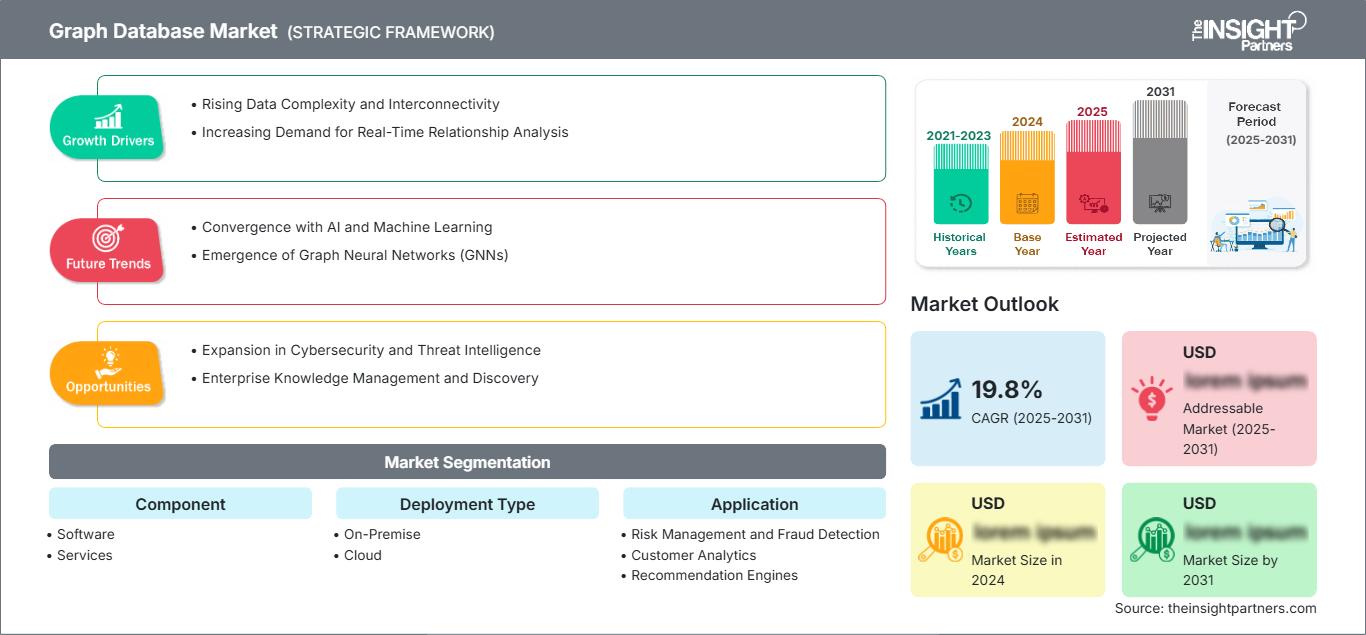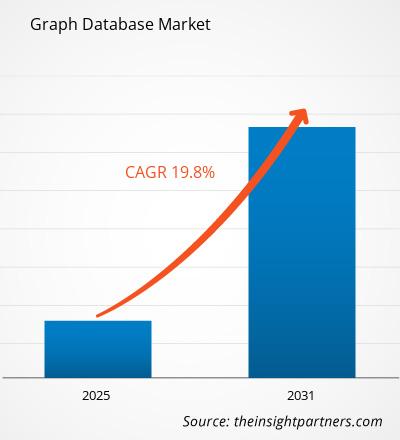Si prevede che il mercato dei database grafici registrerà un CAGR del 19,8% dal 2025 al 2031, con una dimensione del mercato in espansione da XX milioni di dollari nel 2024 a XX milioni di dollari entro il 2031.
Il rapporto è segmentato per componente (software, servizi), tipo di distribuzione (on-premise, cloud), applicazione (gestione del rischio e rilevamento delle frodi, analisi dei clienti, motori di raccomandazione, gestione della catena di fornitura, gestione delle operazioni e gestione delle risorse, gestione della conoscenza, gestione dei dati scientifici, altri), tipo (grafico delle proprietà, framework di descrizione delle risorse), settore verticale (BFSI, sanità, telecomunicazioni e IT, vendita al dettaglio ed e-commerce, trasporti e logistica, governo e settore pubblico, media e intrattenimento, viaggi e ospitalità, produzione, altri). L'analisi globale è ulteriormente suddivisa a livello regionale e per i principali paesi. Il rapporto offre il valore in USD per l'analisi e i segmenti sopra indicati.
Scopo del rapporto
Il rapporto Graph Database Market di The Insight Partners mira a descrivere il panorama attuale e la crescita futura, i principali fattori trainanti, le sfide e le opportunità. Ciò fornirà spunti a vari stakeholder aziendali, come:
- Fornitori/Produttori di tecnologia: per comprendere le dinamiche di mercato in evoluzione e conoscere le potenziali opportunità di crescita, consentendo loro di prendere decisioni strategiche informate.
- Investitori: per condurre un'analisi completa delle tendenze in merito al tasso di crescita del mercato, alle proiezioni finanziarie di mercato e alle opportunità esistenti lungo la catena del valore.
- Organismi di regolamentazione: per regolamentare le politiche e le attività di controllo sul mercato con l'obiettivo di ridurre al minimo gli abusi, preservare la fiducia degli investitori e sostenere l'integrità e la stabilità del mercato.
Componente di segmentazione del mercato del database grafico
- Software
- Servizi
Tipo di distribuzione
- On-premise
- Cloud
Applicazione
- Gestione del rischio e rilevamento delle frodi
- Analisi dei clienti
- Motori di raccomandazione
- Gestione della catena di fornitura
- Gestione delle operazioni e gestione delle risorse
- Gestione della conoscenza
- Gestione dei dati scientifici
- Altri
Tipo
- Grafico delle proprietà
- Framework di descrizione delle risorse
Settore verticale
- BFSI
- Sanità
- Telecomunicazioni e IT
- Vendita al dettaglio ed e-commerce
- Trasporti e Logistica
- Governo e settore pubblico
- Media e intrattenimento
- Viaggi e ospitalità
- Produzione
- Altri
Potrai personalizzare gratuitamente qualsiasi rapporto, comprese parti di questo rapporto, o analisi a livello di paese, pacchetto dati Excel, oltre a usufruire di grandi offerte e sconti per start-up e università
Mercato dei database grafici: Approfondimenti strategici

-
Ottieni le principali tendenze chiave del mercato di questo rapporto.Questo campione GRATUITO includerà l'analisi dei dati, che vanno dalle tendenze di mercato alle stime e alle previsioni.
Fattori di crescita del mercato dei database a grafo
- Crescente complessità e interconnettività dei dati: le organizzazioni stanno sperimentando una crescita esponenziale delle relazioni di dati complesse e interconnesse in ambiti come social network, sicurezza informatica e sistemi di raccomandazione. I database a grafo offrono prestazioni superiori nella navigazione di connessioni dati complesse, consentendo insight più rapidi e analisi basate sulle relazioni più sofisticate rispetto ai database relazionali tradizionali.
- Crescente domanda di analisi delle relazioni in tempo reale: le aziende richiedono una comprensione immediata delle relazioni dinamiche tra entità, che spinge l'adozione dei database a grafo. Dal rilevamento delle frodi nei servizi finanziari all'esperienza cliente personalizzata nell'e-commerce, la capacità di attraversare e analizzare rapidamente punti dati interconnessi è diventata fondamentale per il vantaggio competitivo e l'efficienza operativa.
Tendenze future del mercato dei database a grafo
- Convergenza con intelligenza artificiale e apprendimento automatico: i database a grafo si stanno integrando sempre più con le tecnologie di intelligenza artificiale e apprendimento automatico, consentendo grafici della conoscenza più sofisticati, analisi predittive e sistemi di raccomandazione intelligenti. Questa convergenza consente una comprensione semantica più approfondita, un riconoscimento di pattern migliorato e approfondimenti più sfumati in vari settori come sanità, finanza e tecnologia.
- Emergenza delle reti neurali grafiche (GNN): l'emergere delle reti neurali grafiche (GNN), una classe di modelli di apprendimento automatico progettati per elaborare dati strutturati a grafo, sta guidando l'adozione di database a grafo. Le GNN richiedono database a grafo per archiviare ed elaborare i dati sottostanti e questa sinergia tra GNN e database a grafo sta alimentando la crescita del mercato.
Opportunità di mercato per i database a grafo
- Espansione nella sicurezza informatica e nella threat intelligence: i database a grafo rappresentano un'opportunità di trasformazione nella sicurezza informatica, mappando scenari di minacce complessi, identificando pattern di attacco e consentendo la valutazione del rischio in tempo reale. La loro capacità di visualizzare e analizzare complesse connessioni di rete consente alle organizzazioni di rilevare e mitigare in modo proattivo le minacce informatiche più sofisticate, in modo più efficace rispetto agli approcci di sicurezza tradizionali.
- Gestione e scoperta della conoscenza aziendale: i database grafici offrono un potenziale senza precedenti per la gestione della conoscenza aziendale, consentendo alle organizzazioni di creare repository dinamici e interconnessi di conoscenza istituzionale. Mappando le relazioni tra dati, persone e processi, le aziende possono migliorare la collaborazione, accelerare l'innovazione e prendere decisioni strategiche più consapevoli in ecosistemi organizzativi complessi.
Approfondimenti regionali sul mercato dei database grafici
Le tendenze regionali e i fattori che influenzano il mercato dei database grafici durante il periodo di previsione sono stati ampiamente spiegati dagli analisti di The Insight Partners. Questa sezione illustra anche i segmenti e la geografia del mercato dei database grafici in Nord America, Europa, Asia-Pacifico, Medio Oriente e Africa, America meridionale e centrale.
Ambito del rapporto di mercato del database grafico
| Attributo del rapporto | Dettagli |
|---|---|
| Dimensioni del mercato in 2024 | US$ XX million |
| Dimensioni del mercato per 2031 | US$ XX Million |
| CAGR globale (2025 - 2031) | 19.8% |
| Dati storici | 2021-2023 |
| Periodo di previsione | 2025-2031 |
| Segmenti coperti |
By Componente
|
| Regioni e paesi coperti |
Nord America
|
| Leader di mercato e profili aziendali chiave |
|
Densità degli attori del mercato del database grafico: comprendere il suo impatto sulle dinamiche aziendali
Il mercato dei database grafici è in rapida crescita, trainato dalla crescente domanda degli utenti finali, dovuta a fattori quali l'evoluzione delle preferenze dei consumatori, i progressi tecnologici e una maggiore consapevolezza dei vantaggi del prodotto. Con l'aumento della domanda, le aziende stanno ampliando la propria offerta, innovando per soddisfare le esigenze dei consumatori e sfruttando le tendenze emergenti, alimentando ulteriormente la crescita del mercato.

- Ottieni il Mercato dei database grafici Panoramica dei principali attori chiave
Punti di forza
- Copertura completa: il rapporto copre in modo completo l'analisi di prodotti, servizi, tipologie e utenti finali del mercato dei database grafici, fornendo un panorama olistico.
- Analisi degli esperti: il rapporto è compilato sulla base della conoscenza approfondita di esperti e analisti del settore.
- Informazioni aggiornate: il rapporto garantisce rilevanza aziendale grazie alla sua copertura di informazioni recenti e tendenze dei dati.
- Opzioni di personalizzazione: questo rapporto può essere personalizzato per soddisfare le esigenze specifiche del cliente e adattarsi in modo appropriato alle strategie aziendali.
Il rapporto di ricerca sul mercato dei database grafici può, quindi, aiutare a guidare il percorso di decodificazione e comprensione dello scenario del settore e delle prospettive di crescita. Sebbene possano esserci alcune preoccupazioni valide, i vantaggi complessivi di questo rapporto tendono a superare gli svantaggi.
- Analisi storica (2 anni), anno base, previsione (7 anni) con CAGR
- Analisi PEST e SWOT
- Valore/volume delle dimensioni del mercato - Globale, Regionale, Nazionale
- Industria e panorama competitivo
- Set di dati Excel
Report recenti
Testimonianze
Motivo dell'acquisto
- Processo decisionale informato
- Comprensione delle dinamiche di mercato
- Analisi competitiva
- Analisi dei clienti
- Previsioni di mercato
- Mitigazione del rischio
- Pianificazione strategica
- Giustificazione degli investimenti
- Identificazione dei mercati emergenti
- Miglioramento delle strategie di marketing
- Aumento dell'efficienza operativa
- Allineamento alle tendenze normative






















 Ottieni un campione gratuito per - Mercato dei database grafici
Ottieni un campione gratuito per - Mercato dei database grafici